
22.02.2016
Pedro Neves Marques addresses the hangover in relation to the ideology of progress as translated into the concept of desenvolvimentismo (“developmentism”) in Brazil, within the nascent neoliberal right of South America. Neves analyzes the work of artist Beto Shwafaty and architect Paulo Tavares’s architectural research into the Amazon region.
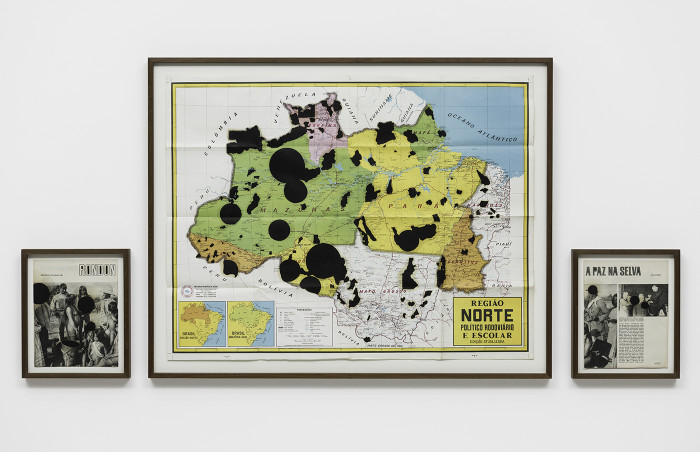
On November 5, 2015, a dam run by the mining company Samarco, owned by the Brazilian company Vale and the Anglo-Australian based BHP, broke loose in the Germano industrial mining area of Bento Rodrigues, near the city of Mariana in the state of Minas Gerais. At least 62m cubic meters of iron ore detritus and muddy water spit into the nearby ecosystems, contaminating the Rio Doce river and its surrounding environments, all the way from the highly touristic region of Minas Gerais to long stretches of white sand in Regência in the coast of the state of Espírito Santo. The river, the land, the vegetation, the animals, and the humans, the beaches and the sea, the local economies, and the biological systems tying nature and culture together along the path ravaged by the detritus have all been dying for three months now. This is the biggest environmental disaster to ever hit the Brazilian territory. Scale notwithstanding, it is nonetheless only the most dramatic of many slow deaths across the country.
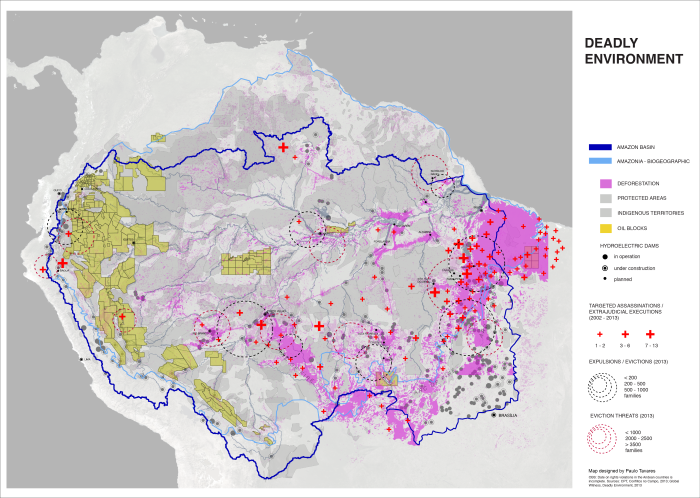
As the above image shows, the Amazon biogeographic region has become in many ways a “deadly environment,” drawn in the intertwining economics of climate change and the persistence of colonial violence in South America. The “Deadly Environment” map was produced by Paulo Tavares, Brazilian architect and researcher who has developed work for and with Goldsmiths Center for Research Architecture in London. More recently, he has exhibited in Berlin’s Haus der Kulturen der Welt’s Forensis exhibition in 2014 and, together with Ursula Biemann, at BAK in Utrecht in 2015. The map is part of Tavares’s forensic and historical research, Amazonia: A Botanical Archaeology of Violence, on the “architecture” of the Amazon forest and the violence attached to its industrial development since the 1950s. Besides extensive archival material and a dialogue with archaeologists such as Michael Heckenberger and Eduardo Neves, he has been using satellite imagery and botanical knowledge to map and connect the age of the rainforest to genocidal crimes against indigenous communities close to extraction sites, such as the Waimari Atroari. In his own words, this “map compiles data on human rights violations gathered from reports produced by the NGOs Pastoral da Terra, Conselho Indigenista Missionário and Global Witness, in combination with GIS information on indigenous territories, location of dams and oil exploitation, and deforestation.”(1)
To the East of the map one can see the absurd numbers of targeted assassinations and population displacement correlated to logging and deforestation, and to the West, as the rainforest rises from the states of Acre and Amazonas up the Peruvian and Ecuadorian mountain range, the Amazon appears transformed into a gigantic oil extraction site. At the center of the map, down from Santarém, lies the Belomonte Dam project and the Carajás mine, the biggest open air iron mine in the world, on the map also appears the biggest open air gold mine, located in Paracatu, in the state of Minas Gerais. To the South of the map, like a ravaging smile, there is the “Arc of Fire”, cutting across the state of Mato Grosso. This is perhaps one of the fastest and most intense terraformation sites in all of South America, whereby forest areas and the great plains of the southern Amazonian ecosystem have been transformed into vast monocultures of soy, corn, sugar cane, or cotton—here again, the map connects deforestation with the targeted killings of mostly indigenous populations and land activists.
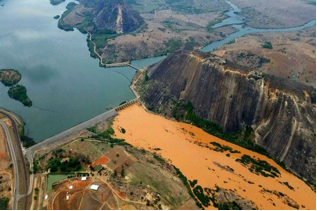
Like the Mariana disaster, many more sites of violence mark the Brazilian territory outside of this cartographic boundary. These sites are characterized not only by direct, but also slow violence. The accelerated monocrops of the agricultural states, for instance, are revealing, for they would not be possible without the intense use of pesticides and transgenic seeds. Brazil is the world’s first consumer of pesticides and other agricultural chemicals, with people ingesting on average up to six liters of pesticides a year, and some of the most chemical crops are those destined for biofuel and livestock such as soy, corn, sugar cane, and cotton.(2)
Progress and production come at the cost of contamination and cancer; these regions are traversed, molecularly, by a pool of pesticides traveling in the subsoil and in the air, all of which deregulated like a colossal machine running on cheap or slave labor, and where the grid system of production and transportation stands above any human or nonhuman being or culture. While the mega fluvial port of Santarém is not open, thus paving the way for agricultural goods and cattle to be shipped via the Amazon basin and up through the Panamá Canal, all of this production continues to travel down South to the ports of Santos in São Paulo and Vitória in Espírito Santo. Brazil is famously the world’s lung, but it is also its farm. Unsurprising, given that the “ruralists” hold on the Brazilian political system—a system which, given the incapacity for an agrarian reform, still follows its inherited colonial landlord structure. The ruralists have taken advantage, if not partially orchestrated, the current political crisis, and are pushing for an amendment allowing for the use of Terminator seeds: infertile GMO seeds, lasting for a season only. This law, PL 1117, would make Brazil the first country to break from the 2000 U.N. Terminator seed ban, signed by 192 countries. Its consequences are predictable, with risk of genetic contamination of the ecosystems and further entrenchment of slave labor and agricultural dependency on corporations such as Monsanto or Syngenta. Similarly, the recently approved, though still under contestation, PEC 215 will instantly stop any further indigenous demarcation of territories and even retract those accomplished since the 1988 Brazilian Constitution whenever land is considered of “relevant public interest.” In other words, further monopolization of the land.(3)
This landscape, toxic and contaminated by conflict, is the consequence of what in Brazil is called desenvolvimentismo (developmentism). For the corporatized Brazilian state, the modern way is the extractivist way, with little difference between today and the colonial Brazil of the entradas and bandeirantes (exploring and exploiting inner Brazil either for the Portuguese crown or privately, respectively). Sadly, regardless of the Workers’ Party‘s revolutionary politics of inclusion and redistribution, developmentist ideology cuts across parties—as the anthropologist Eduardo Viveiros de Castro once stated, the Workers’ Party is a nineteenth-century mentality party, though one can only imagine the stepping up of violence under the media-based neoliberal right.(4)
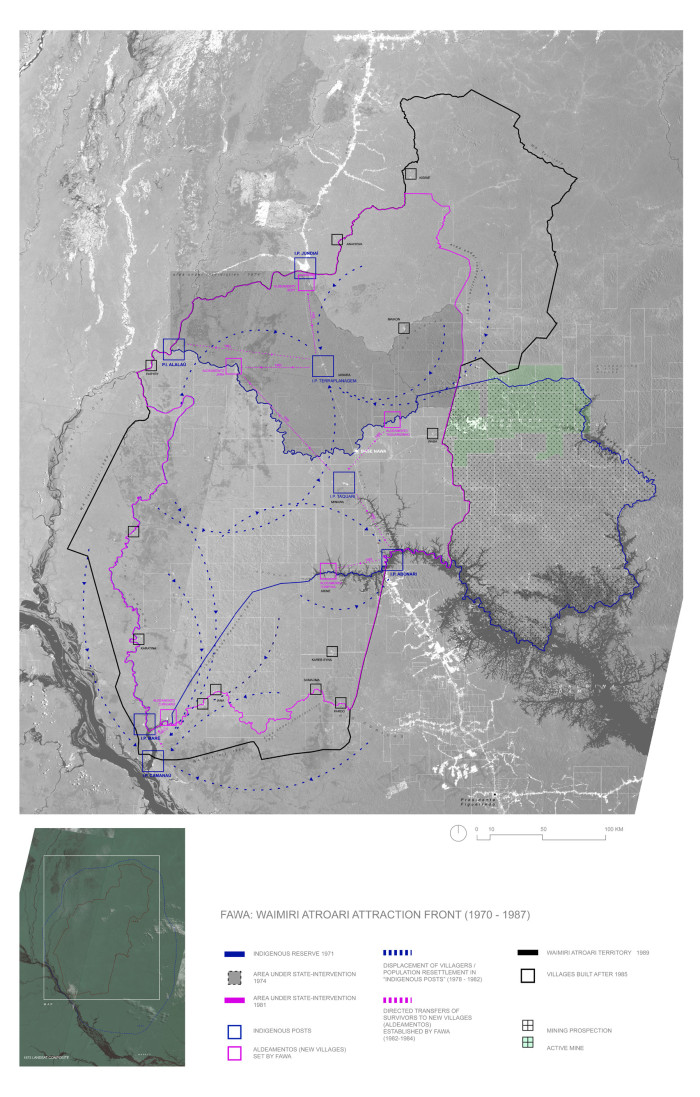
Paulo Tavares exemplifies how Brazilian tropical modernity conceals, behind its state propaganda, a chemical Brazil. Along with fellow researchers at Forensis, his research translates the contaminated ecosystems and economics of climate change terraforming activities into an exercise on visuality beyond commonplace environmentalist snapshots, tying concrete technological devices and inhuman imagery (Landsat radiometry, for example) to legal accountability cases. Inhabiting a contaminated world demands participation in an enhanced reality, where not only humans and nonhumans must interact, as in Actor-network-theory, but where, just as importantly, images of the visible and the invisible (be it chemical trails or the age and fertility of the forest) must be combined for us to become familiar with a textured world beyond our perceptive apparatus. In the words of architect Eyal Weizman, with whom Tavares has often worked, “the ability of images to both create and destroy.”(5)
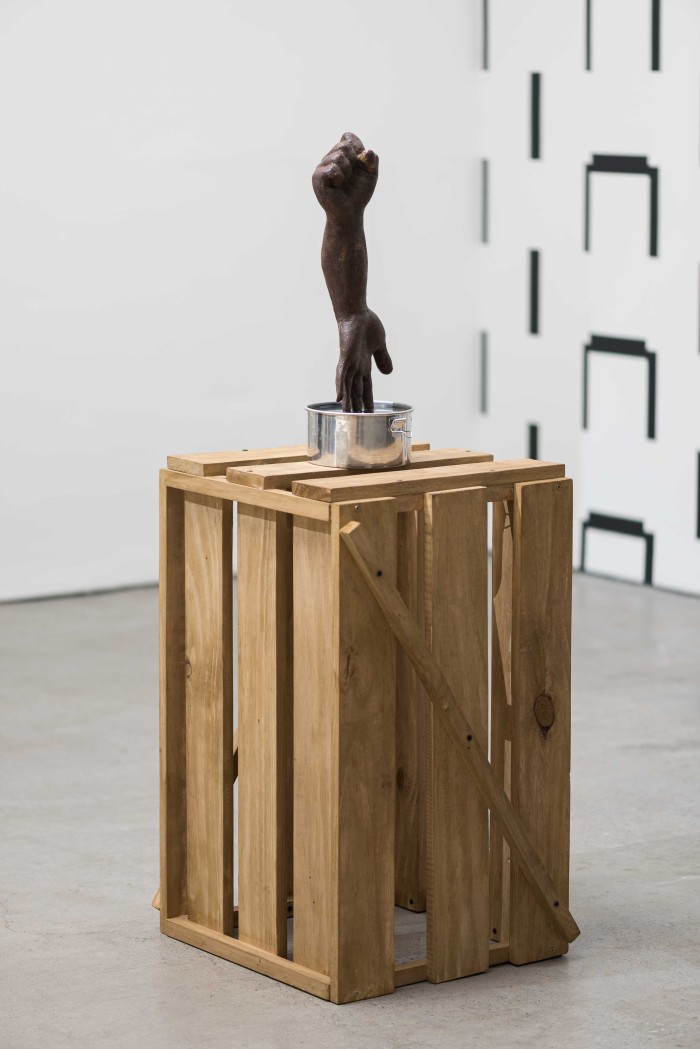
Visual artist Beto Shwafaty is one of the few Brazilian artists I know of working on such developmental politics, not in an allegorical way or a sensorial surface of representation (abounding in Brazilian arts), rather through a long-term methodical inquiry on the historical intertwinement between political and historical agents, architecture, and the arts. In my mind, Shwafaty’s practice has for some time now been a counterpart to Tavares’s cartography—and it is perhaps no surprise that they have long engaged in a dialogue on these matters. Their discussion has helped open up the infrastructural and cultural network which has, especially from the fall of the second Vargas presidency in the mid-1950s onwards, sustained the destructive—despite some progressively minded criticism and support of elites—management of land, population, energy, and, why not, aesthetics.
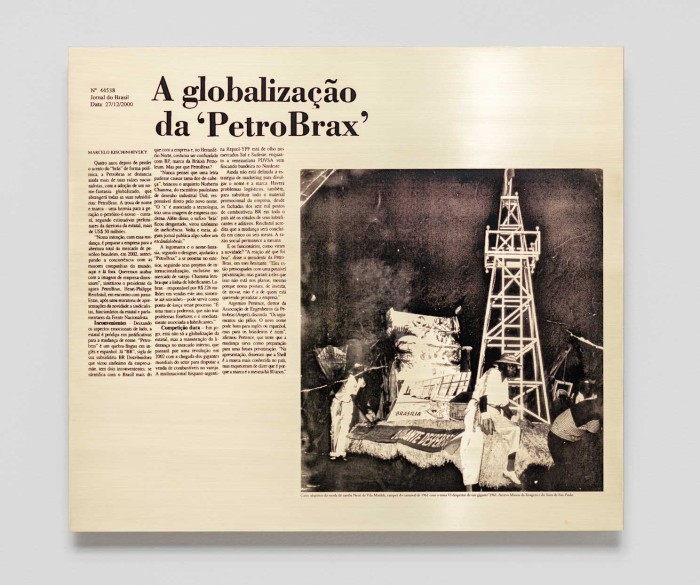
If tropicalism (and neo-concretist aesthetics, which from the edification of Brasília onwards was proclaimed the nation’s official style) persists languidly within much Brazilian art, the trope is revisited in Shwafaty’s installations and videos not as genealogical legitimacy (a way of inscribing one’s art in its tradition of color, body, and geometry) but as to narrate the power play of such aesthetics within the nationalist politics of the country as both form and content—perhaps similarly to how Abstract Expressionism in the USA can be framed, sociologically, via its CIA sponsorship. Contract of Risk, his latest show at Galeria Luísa Strina, approached it through the history of the headquarters of Brazilian oil company, Petrobrás, in Rio de Janeiro. Always conscious of exhibition display, Shwafaty’s environment of objects narrated the subsumption of progressive ideas by industrialization, fetishized in Brazil in the shape of Petrobrás, who in its turn adorned the building with abstract, neo-concretist style reinforced concrete reliefs—the famous landscape architect Burle Marx also designed its interior hanging gardens. A series of sculptures recreate parts of the building’s reliefs and, together with serigraphs of newsprints ranging from the building’s opening stages in the early 1970s to today, the works recall episodes of the life and public reception of the Petrobrás headquarters. Such references include the company’s past promises of urban revitalization and recent collapse, where it now is mired by corruption.(6) A black and white wall-painting based on the abstract-tilling pattern of another Petrobrás building (located in Brasília and designed by Athos Bulcão in the early 1960s) is also appropriated by Shwafaty, altered in its stable visual rhythm to evoke a constant state of growth from a grid to a deep, oily black.
His sculpture of the same title (to which he added the subtitle: The Worker, Politician, Intellectual and Revolutionary) despite operating at a more symbolic or representational level again encapsulates the Janus-like face of progressive ideas in Brazil in a single image, with a worker’s bicephalous hand clenched into a fist and raised high on top of another hand that digs into a miserable saucepan (used by workers to carry food) filled with black rubber, in an allusion to oil. Another sculpture of similar nature, titled Aculturação (não) é integração I (2015) shows a traditional ceramic vase painted with the logo of the mining company Vale do Rio Doce, which runs the Carajás mine and is now at the center of the Mariana debacle. This iconic production of industrial imagery recalls some of the best moments of Cildo Meireles, a challenging comparison in the Brazilian arts.
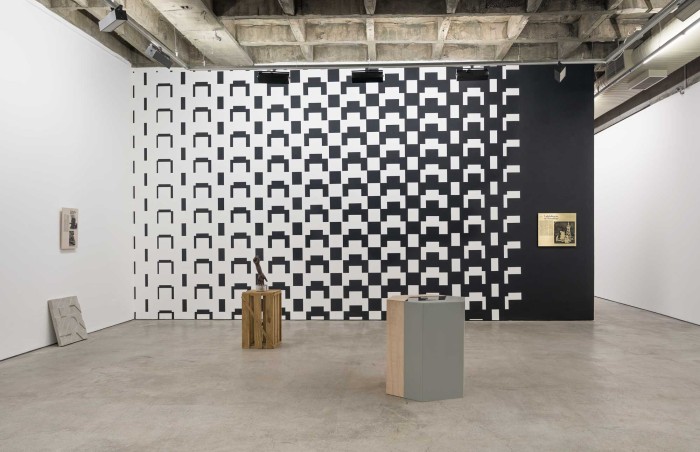
As in Tavares’ architectural and ecological research, the social role of technology and industry is an essential aspect of Shwafaty’s politics. But while Tavares puts said social role of technology to use in order to expand the technological and cosmopolitical limits of ecological politics, Shwafaty refers to its ideological deployment in the social grid of the country, both a psychological grid (backwards/ progressive, bastard/ modern, socialist/ capitalist, and so on) and a very concrete geopolitical and energetic territorial grid of power and disavowal.
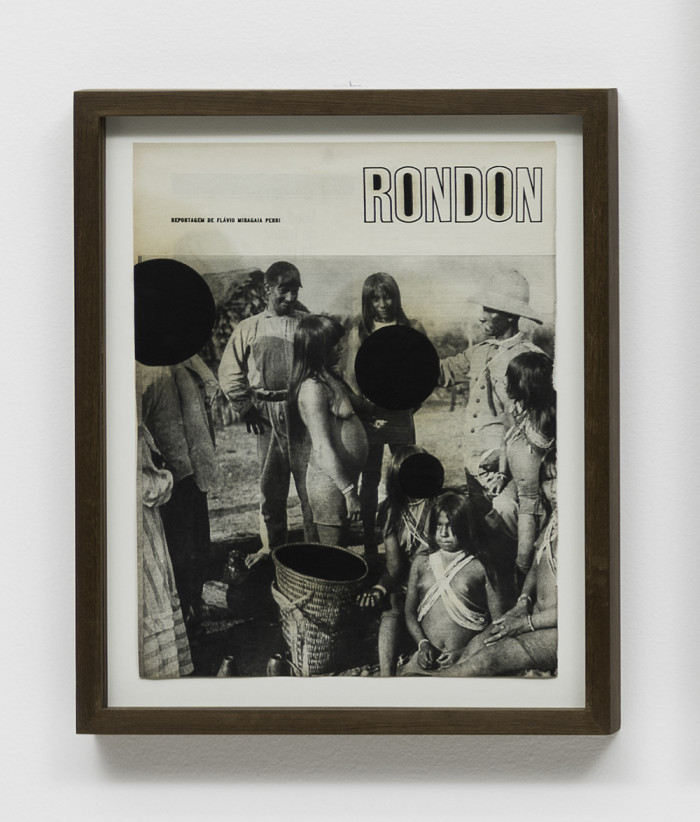
We need a proper name for events such as the iron ore dam leak in Mariana (among many countless others in Brazil and elsewhere). These are not disasters, but negligence. This is what the work of Tavares and Shwafaty allow us to rethink—while finger pointing at institutional failures to maintain responsibilities, technologies, state and corporate apparatuses.
The Mariana disaster is promptly being brandished like a blade by Brazil’s neoliberal right, ready to deal a final blow to the by now calamitous Dilma Roussef’s government. But disasters such as these only reinforce an image of Third-Worldism across the Atlantic and the Gulf of Mexico, in the eyes of the so-called developed world, reinscribing the colonial loop back in Brazil (or any other “developing world”), limiting it, again and again, to the status of “country of the future”, always to come but never arriving, to which Austrian author Stefan Zweig once condemned it. This is the case even as similar disasters crack-open the molecularity the earth in the United States, in Europe, Japan, and so on. Even as California’s Porter Ranch methane leak has kept on unleashing gas (more than 83,000 metric tons) since October, contaminating the air across LA’s San Fernando Valley(7)—but anyway, as anyone who as lived in the United States knows, the US is a Third World country disguised as First World.
To call such incidents disasters is to allow ourselves to fantasize them, delusional of the specter of natural disasters within climate change debate. These events relate to the ecological crisis both as cause and consequence. That the United Nations classifies them as Human Rights disasters is not much better either, for such nomenclature leaves the wider trans-ontological network of agencies, histories, and cosmologies closed and opaque. The Mariana and Rio Doce disasters are impacting populations, economies and the environment, as long as the environment is understood a-historically and a-anthropologically. For if the environment of Minas Gerais can only be understood historically through its colonial management and terraformation, on the other hand, what appears to us (and especially the UN) simply as a biodiverse environment is to indigenous communities an intense social space full of beings and worlds otherworldly to us. What then must be the scale and scope of the remediation for such genocide?
Notes:
(1) Paulo Tavares, private email exchange, January 2016.
(2) See, among other sources, Mariana Rossi, “O alarmante uso de agrotóxicos no Brasil atinge 70% dos alimentos,” El País, 20-04-2015, last acessed 16-01-2016 http://brasil.elpais.com/brasil/2015/04/29/politica/1430321822_851653.html
(3) See among other sources Instituto Socioambiental’s webpage on the topic: http://www.socioambiental.org/pt-br/tags/pec-215
(4) Eduardo Viveiros de Castro, “A escravidão venceu no Brasil. Nunca foi abolida,” interview by Alexandra Lucas Coelho, Público, 16.03.2014.
(5) “The Anthropocene Issue: Episode 2009,” Inhabitants, December 2015. http://inhabitants-tv.org/dec2015_specialseries_theanthropoceneissue.html
(6) For more information about the corruption scandals involving Petrobras and high-raking government officials, see El País dedicated webpages on the topic: http://brasil.elpais.com/tag/caso_petrobras/a/ and http://brasil.elpais.com/tag/petrobras/a/
(7) Lorraine Chow, Porter Ranch Methane Leak Spreads Across LA’s San Fernando Valley, Ecowatch, 15-01-2016 https://ecowatch.com/2016/01/15/porter-ranch-methane-leak-spreads/
Comments
There are no coments available.